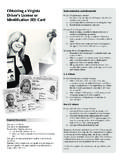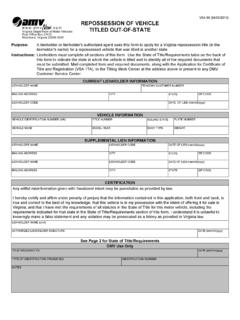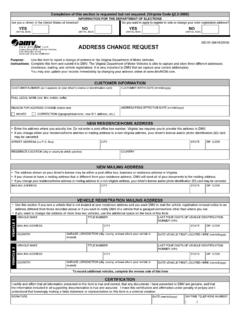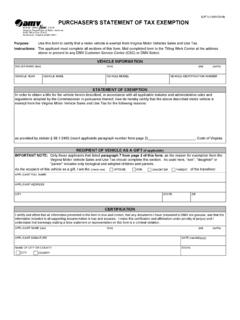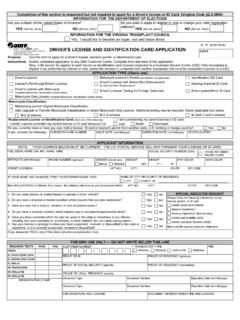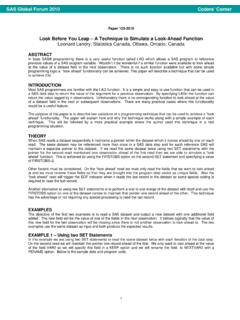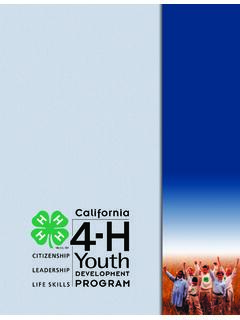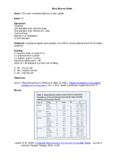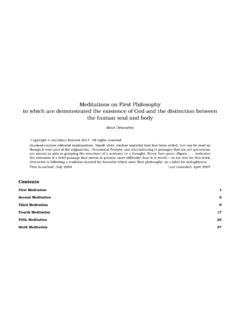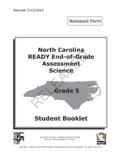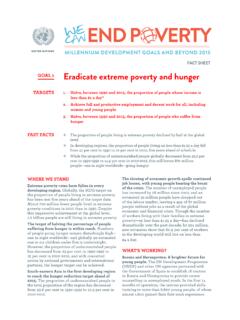Transcription of Driver License Commercial
1 CommercialDriver LicenseManual2005 CDL Testing SystemVersion: July 2017 CDL Driver s ManualCOPYRIGHT 2005 AAMVAAll Rights Reserved This material is based upon work supported by the Federal Motor Carrier Safety Administration under Cooperative Agreement No. DTFH61-97-X-00017. Any opinions, findings, conclusions or recommendations expressed in this publication are those of the Author(s) and do not necessarily reflect the view of the Federal Motor Carrier Safety Administration. COPYRIGHT 2005 AAMVA. All rights reserved This material has been created for and provided to State Driver License Agencies (SDLAs) by AAMVA for the purpose of educating Driver License applicants ( Commercial or Non- Commercial ). Permission to reproduce, use, distribute or sell this material has been granted to SDLAs only. No part of this book may be reproduced or transmitted in any form or by any means, electronic or mechanical, including photocopying, recording, or by any information storage and retrieval system without express written permission from the author / publisher.
2 Any unauthorized reprint, use, distribution or sale of this material is prohibited. In January 2015, an RV pulled into a truck stop in Virginia. Observant professional truck Driver Kevin Kimmel recognized suspicious activity around that RV, which had pulled back by the truck line, and decided something was off. Instead of turning a blind eye, he made a call that brought law enforcement out to the scene within a few minutes. After interviewing the occupants of the vehicle, they discovered that a young woman, 20 years old, had been kidnapped from Iowa two weeks prior. She had been beaten, raped, her whole body burned by instruments heated on the RV stove, branded and starved. She was being sold by her traffickers, Laura Sorenson and Aldair Hodza, through sex ads on Craigslist, where men were purchasing her and then arriving at the RV to rape her. She was dying from malnutrition and the torture she was subjected to .. had the call not been made that brought law enforcement out to that truck stop, doctors said she would have died within the next few days.
3 Now a recovering survivor, this young woman calls Kimmel her guardian angel. He calls himself a Trucker Against Trafficking. Truckers Against Trafficking is a non-profit organization that has been working with the trucking industry since 2009 to provide the needed training and tools to enable members of the industry to both recognize human trafficking when they see it happening and to know what actions to take to enable law enforcement to effectively fight this crime. Through this training and these tools, truckers are becoming Everyday Heroes like Kevin Kimmel, who was also named TAT s 2015 Harriet Tubman Award winner. One of the tools TAT provides is a wallet card with red flags to look for, questions to ask if you suspect someone is a victim and actionable information to report. This wallet card is available by App, from the appropriate App Store, on all smart phones, whether Android, iPhone or Windows format, as well as by emailing for a version to carry in your wallet. Additionally, TAT provides a powerful, 26-minute training video on its website ( ), which, when watched along with taking and passing a short test, certifies drivers as TAT-Trained, a designation which can go on your resume.
4 Because professional drivers often find themselves in locations frequented and exploited by human traffickers, they are in a unique position to recognize the signs of human trafficking and to make the call that can lead to victim recovery and perpetrator arrests. Get your wallet card today. Be an Everyday Hero! Make the call (1-888-3737-888); save lives! Table of Contents Introduction .. 1-1 Driving Safely .. 2-1 Transporting Cargo Safely .. 3-1 Transporting Passengers Safely .. 4-1 Air Brakes .. 5-1 Combination Vehicles .. 6-1 Doubles and Triples .. 7-1 Tank Vehicles .. 8-1 Hazardous Materials .. 9-1 School Bus .. 10-1 Vehicle Vehicle Inspection .. 11-1 Basic Vehicle Control Skills Test .. 12-1 On-Road Driving .. 13-1 THIS PAGE INTENTIONALLY LEFT BLANK Commercial Driver s License Manual 2005 CDL Testing System Section 1 - Introduction Page 1-1 Version: July 2017 Section 1 INTRODUCTION This Section Covers Commercial Driver License Tests Medical Requirements Driver Disqualifications Other Safety Rules International Registration Program There is a federal requirement that each state have minimum standards for the licensing of Commercial drivers .
5 This manual provides Driver License testing information for drivers who wish to have a Commercial Driver License (CDL). This manual does NOT provide information on all the federal and state requirements needed before you can drive a Commercial motor vehicle (CMV). You may have to contact your state Driver licensing authority for additional information. You must have a CDL to operate: Any single vehicle with a gross vehicle weight rating (GVWR) of 26,001 pounds or more. A combination vehicle with a gross combination weight rating (GCWR) of 26,001 or more pounds, provided the GVWR of the vehicle(s) being towed is in excess of 10,000 pounds. A vehicle designed to transport 16 or more passengers (including the Driver ). Any size vehicle which requires hazardous material placards or is carrying material listed as a select agent or toxin in 42 CFR part 73. Federal regulations through the Department of Homeland Security require a background check and fingerprinting for the Hazardous Materials endorsement.
6 Contact your local department of Driver licensing for more information. (Your state may have additional definitions of CMVs.) CDL Classifications The CDL vehicle classification included in the federal standard, together with the type of cargo to be transported, determine what type of CDL License and endorsement an applicant must apply for. There are three basic vehicle classes or groups: Class A Combination Vehicles. Any combination of vehicles with gross combination weight rating (GCWR) of 26,001 or more pounds falls in Group A provided the GVWR of the vehicle(s) being towed is more than 10,000 pounds. Most Class A vehicles are trucks such as truck-tractor/semi-trailer or truck and trailer combinations. However, tractor-trailer buses may be found in a few communities. Driving a Class A vehicle requires considerably more skill and knowledge than driving vehicles in Classes B and C. Since these skills include those required to drive a B and C vehicle, a Driver who has a Class A License also may drive vehicles in Classes B and C.
7 Class B Heavy Straight Vehicles. Any single vehicle with a GVWR of 26,001 or more pounds falls in Group B, or any such vehicle towing another vehicle not in excess of 10,000 pounds GVWR. Class B includes straight trucks and large buses, including articulated buses. Safely driving these heavy vehicles requires considerably more knowledge and skill than driving the small trucks and buses found in Class C. Since they include the skills required to drive Class C vehicles, drivers who have qualified for a Class B License may also drive vehicles in Class C. Class C Small Vehicles. Any single vehicle with a GVWR less than 26,001 pounds falls in Group C, or any such vehicle towing another vehicle not in excess of 10,000 pounds GVWR. However, vehicles of this size are included in the CDL program only if they are: 1) Designed to carry 16 or more passengers including the Driver , or (2) Used to transport hazardous materials in quantities requiring placarding under the Hazardous Materials Regulations (49 CFR Part 172, Subpart F) or is carrying material listed as a select agent or toxin in 42 CFR part 73.
8 There are a great variety of vehicles in Class C. Some rather large Class C vehicles may require more skill and knowledge to operate than do the smaller ones. However, the licensing category is based principally on the type of cargo carried. Because of the seriousness of an accident involving hazardous material or human passengers, the safe operation of even the smaller vehicles in Class C requires special knowledge and the drivers of these vehicles must have a CDL. STATE OPTIONS: Some states may include more drivers and vehicles in their CDL programs. For example, in some states, a CDL may be required for buses designed to carry fewer than 16 passengers. Going beyond the federal standard is acceptable and the state will need to decide which battery of tests applies to these drivers , or develop a new battery. Commercial Driver s License Manual 2005 CDL Testing System Section 1 - Introduction Page 1-2 Version: July 2017 CDL Endorsements & Restrictions Endorsements All Commercial drivers who drive certain types of vehicles or haul certain types of cargo must add endorsements to their CDL License and/or Commercial Learner s Permit (CLP) to show that they have the specialized knowledge required for these operations.
9 There are six kinds of CDL endorsements that may be required, depending on the vehicle or type of cargo. NOTE: The only endorsements that may be added to a Commercial Learner s Permit (CLP) are: - Passenger (P); - School bus (S); and - Tank vehicle (N). Double and Triple Trailers (T). Many drivers who are qualified to drive Class A vehicles may wish to pull double or triple trailers. Research shows that considerable additional knowledge and skill is necessary to safely pull double and triple trailers in various traffic conditions and driving environments. Consequently, adding the endorsement to the licenses of Class A drivers is necessary if they wish to pull double or triple trailers. A special knowledge examination on the problems associated with pulling multiple trailers must be passed. Tank Vehicle (N). drivers of any Commercial motor vehicle that is designed to transport any liquid or gaseous materials within a tank or tanks having an individual rated capacity of more than 119 gallons and an aggregate rated capacity of 1,000 gallons or more that is either permanently or temporarily attached to the vehicle or the chassis must obtain this endorsement.
10 Applies to Class A, B and C (only applicable to Class C if the vehicle is hauling hazardous materials) vehicles. Liquids in bulk cause driving control problems because the cargo is heavy, prone to shifting, and has a high center of gravity. These drivers must pass a special knowledge examination on the problems posed by large volume liquid cargos to add the endorsement to their CDL/CLP. Passengers (P). drivers who wish to drive a vehicle having a design capacity to carry 16 or more people, including the Driver , must add a passenger endorsement to their CDL/CLP. They must pass a special knowledge examination on safety considerations when transporting passengers and must pass skills tests in a passenger vehicle. The endorsement applies to applicants who wish to drive a bus in any class (A, B, or C). Hazardous Materials (H). Any Driver , regardless of the vehicle Class/Group (A, B, or C) who wishes to haul any material that has been designated as hazardous under 49 5103 and is required to be placarded under subpart F of 49 CFR part 172; or any quantity of a material listed as a select agent or toxin 42 CFR Part 73 must add a hazardous materials endorsement to their CDL.
